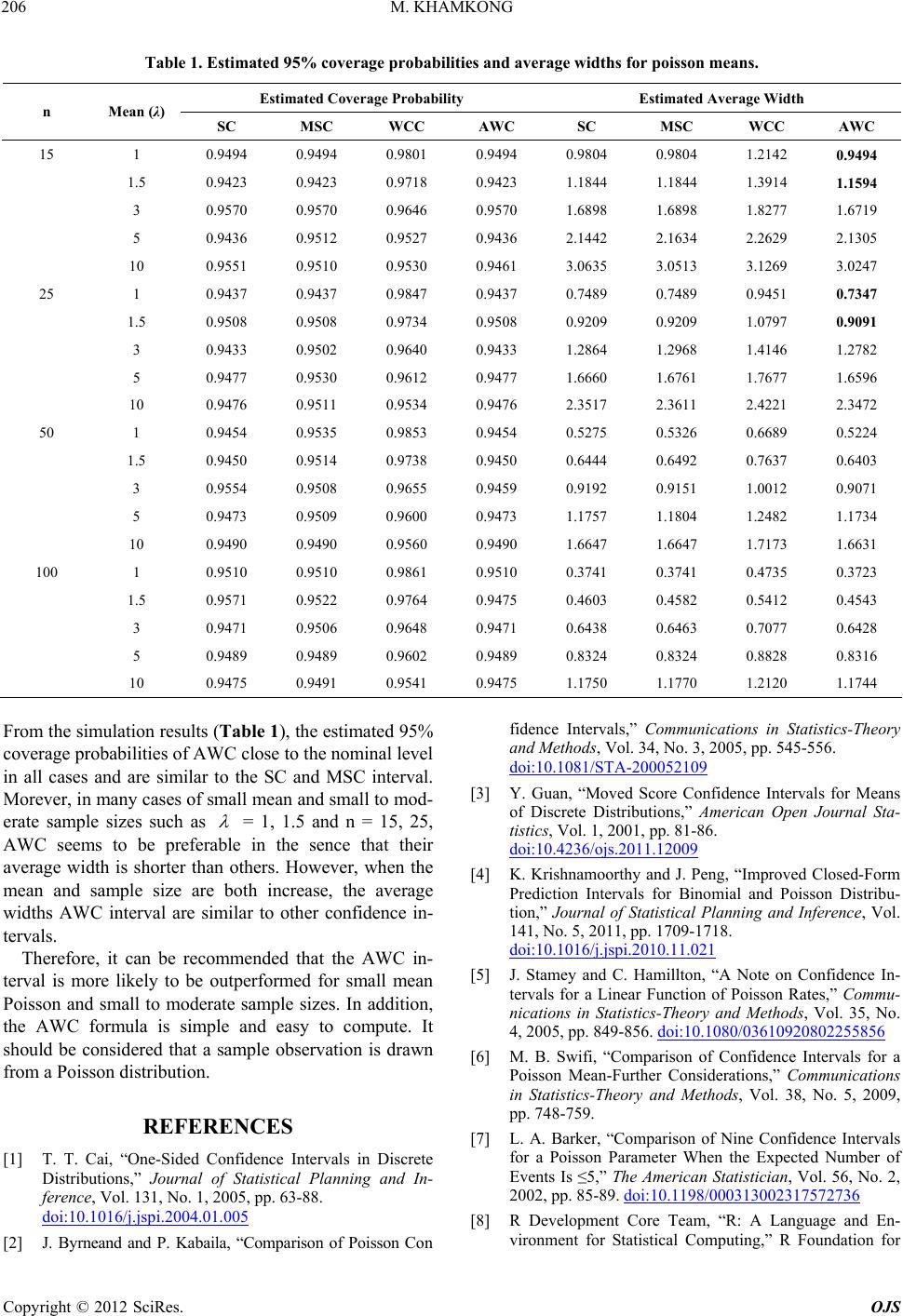
M. KHAMKONG
Copyright © 2012 SciRes. OJS
206
Table 1. Estimated 95% coverage probabilities and average widths for poisson means.
Estimated Coverage Probability Estimated Average Width
n Mean (λ) SC MSC WCC AWC SC MSC WCC AWC
15 1 0.9494 0.9494 0.9801 0.9494 0.9804 0.9804 1.2142 0.9494
1.5 0.9423 0.9423 0.9718 0.9423 1.1844 1.1844 1.3914 1.1594
3 0.9570 0.9570 0.9646 0.9570 1.6898 1.6898 1.8277 1.6719
5 0.9436 0.9512 0.9527 0.9436 2.1442 2.1634 2.2629 2.1305
10 0.9551 0.9510 0.9530 0.9461 3.0635 3.0513 3.1269 3.0247
25 1 0.9437 0.9437 0.9847 0.9437 0.7489 0.7489 0.9451 0.7347
1.5 0.9508 0.9508 0.9734 0.9508 0.9209 0.9209 1.0797 0.9091
3 0.9433 0.9502 0.9640 0.9433 1.2864 1.2968 1.4146 1.2782
5 0.9477 0.9530 0.9612 0.9477 1.6660 1.6761 1.7677 1.6596
10 0.9476 0.9511 0.9534 0.9476 2.3517 2.3611 2.4221 2.3472
50 1 0.9454 0.9535 0.9853 0.9454 0.5275 0.5326 0.6689 0.5224
1.5 0.9450 0.9514 0.9738 0.9450 0.6444 0.6492 0.7637 0.6403
3 0.9554 0.9508 0.9655 0.9459 0.9192 0.9151 1.0012 0.9071
5 0.9473 0.9509 0.9600 0.9473 1.1757 1.1804 1.2482 1.1734
10 0.9490 0.9490 0.9560 0.9490 1.6647 1.6647 1.7173 1.6631
100 1 0.9510 0.9510 0.9861 0.9510 0.3741 0.3741 0.4735 0.3723
1.5 0.9571 0.9522 0.9764 0.9475 0.4603 0.4582 0.5412 0.4543
3 0.9471 0.9506 0.9648 0.9471 0.6438 0.6463 0.7077 0.6428
5 0.9489 0.9489 0.9602 0.9489 0.8324 0.8324 0.8828 0.8316
10 0.9475 0.9491 0.9541 0.9475 1.1750 1.1770 1.2120 1.1744
From the simulation results (Table 1), the estimated 95%
coverage probabilities of AWC close to the nominal level
in all cases and are similar to the SC and MSC interval.
Morever, in many cases of small mean and small to mod-
erate sample sizes such as
= 1, 1.5 and n = 15, 25,
AWC seems to be preferable in the sence that their
average width is shorter than others. However, when the
mean and sample size are both increase, the average
widths AWC interval are similar to other confidence in-
tervals.
Therefore, it can be recommended that the AWC in-
terval is more likely to be outperformed for small mean
Poisson and small to moderate sample sizes. In addition,
the AWC formula is simple and easy to compute. It
should be considered that a sample observation is drawn
from a Poisson distribution.
REFERENCES
[1] T. T. Cai, “One-Sided Confidence Intervals in Discrete
Distributions,” Journal of Statistical Planning and In-
ference, Vol. 131, No. 1, 2005, pp. 63-88.
doi:10.1016/j.jspi.2004.01.005
[2] J. Byrneand and P. Kabaila, “Comparison of Poisson Con
fidence Intervals,” Communications in Statistics-Theory
and Methods, Vol. 34, No. 3, 2005, pp. 545-556.
doi:10.1081/STA-200052109
[3] Y. Guan, “Moved Score Confidence Intervals for Means
of Discrete Distributions,” American Open Journal Sta-
tistics, Vol. 1, 2001, pp. 81-86.
doi:10.4236/ojs.2011.12009
[4] K. Krishnamoorthy and J. Peng, “Improved Closed-Form
Prediction Intervals for Binomial and Poisson Distribu-
tion,” Journal of Statistical Planning and Inference, Vol.
141, No. 5, 2011, pp. 1709-1718.
doi:10.1016/j.jspi.2010.11.021
[5] J. Stamey and C. Hamillton, “A Note on Confidence In-
tervals for a Linear Function of Poisson Rates,” Commu-
nications in Statistics-Theory and Methods, Vol. 35, No.
4, 2005, pp. 849-856. doi:10.1080/03610920802255856
[6] M. B. Swifi, “Comparison of Confidence Intervals for a
Poisson Mean-Further Considerations,” Communications
in Statistics-Theory and Methods, Vol. 38, No. 5, 2009,
pp. 748-759.
[7] L. A. Barker, “Comparison of Nine Confidence Intervals
for a Poisson Parameter When the Expected Number of
Events Is ≤5,” The American Statistician, Vol. 56, No. 2,
2002, pp. 85-89. doi:10.1198/000313002317572736
[8] R Development Core Team, “R: A Language and En-
vironment for Statistical Computing,” R Foundation for